New suspension and a more modern appearance enhance a pair of classic Yamaha two-stroke motocross machines.
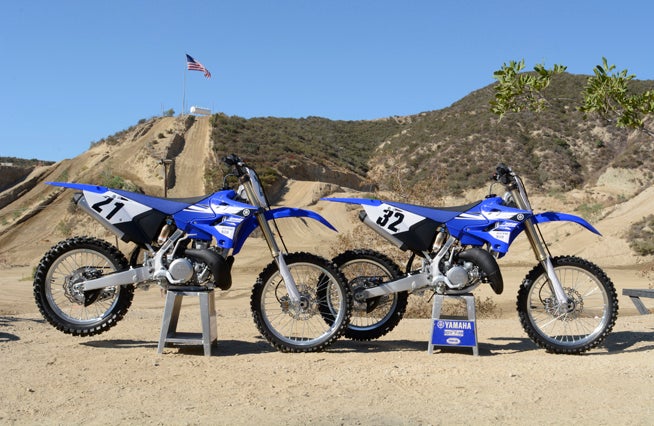
“We sell fun.”
Whenever I see the Yamaha name or watch one of its motorcycles go by, that’s the first think that echoes in my head. It’s a credo that I heard Bob Starr, Yamaha Motor Corporation USA’s General Manager of Communications, recite over and over again during my earliest days in the industry, and it has stuck with me ever since.
Those words were ring-dinging through my conscience in concert with the beautiful high-pitched sound of Yamaha’s 2015 YZ125 and YZ250 two-strokes at Glen Helen Raceway on a sweltering hot Tuesday afternoon as I tried my best to give current World Off-Road Championship Series number-one plate holder Robby Bell a hard time by cutting off half the course and jumping back in front of him every time he passed me…Wait, should I say “lapped” me? Well, technically, if I am cutting the track, he is really just passing me again…
Ah, it doesn’t matter. We were both having too much fun to keep track of laps and passes. Bell was being his usual blazing-fast self aboard the 2015 YZ250, while I spent time reacquainting myself with perhaps the single most fun-sized engine displacement on the planet by wringing the hell out of the 2015 YZ125’s motor. If it weren’t for the 108-degree heat, we might have kept going all day. That’s just how much fun Yamaha’s two-stroke motocross machines are. You’ll want to ride ’em until you drop.
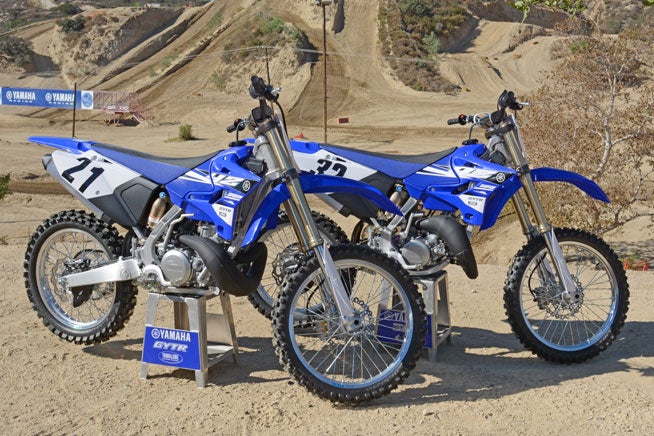
Truth be told, since two-strokes have been out of vogue in AMA National motocross competition for a long time, no one could have blamed Yamaha for going the route of its “Big Four” Japanese competitors and dropping 125cc and 250cc two-strokes from its dirt lineup entirely, but we’re glad Yamaha didn’t. YZ125s and YZ250s are still available on showroom floors every year, and every year motocross purists, two-stroke fans and dirtbike riders with a head for value snap them up like there’s no tomorrow. Except that in the case of the YZ two-strokes, there is a tomorrow. As if it hasn’t already been proven, Yamaha officials say that the company remains committed to its two-strokes for the long haul, and 2015 is a prime example of that commitment. Yamaha is not only keeping the YZ125 and YZ250 in its lineup, but the company has actually invested a few R&D dollars to upgrade both models and make them the best production two-stroke YZs the planet has ever known.
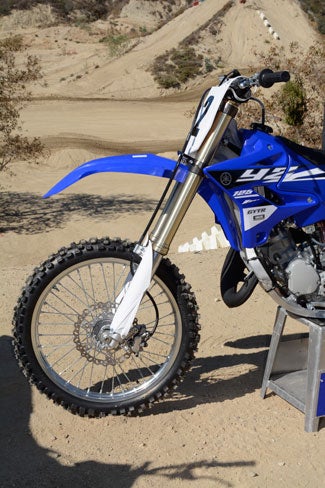
Both machines also get a new adjustable clutch perch that allows the rider to easily select a clutch lever position for maximum comfort. That only makes sense, as you’re liable to spend a little more time fanning the clutch on a two-stroke anyway, right? Other minor changes include design revisions to the rear sprocket, rear brake disc protector and rear brake caliper protector.

But it’s the heart of these premix burners that defines them. Their snappy power is classic two-stroke all the way, assisted by Yamaha Power Valve Systems (YPVS) that broaden their torque and power delivery by raising and lowering their exhaust ports (and thus altering the engine compression ratio). It’s interesting to note that, unlike their four-stroke sisters, the YZ125 and YZ250 both feature undersquare bore and stroke figures. The 125’s is just barely so, measuring 54.0 x 54.5mm, while the 250’s is more pronounced, measuring 66.4 x 72.0mm. Just imagine how freakish the YZ250’s powerband might be if it carried the same 77.0 x 53.6mm bore and stroke as the YZ250F. It might give whole new meaning to the term explosive power!
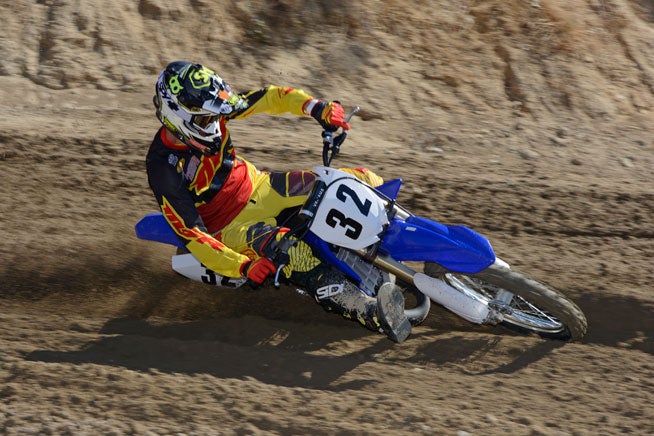
As we learned with Robby Bell’s help, however, there’s really no need for further development to achieve a change in power. Both of these machines have plenty of beans for all but the hardest of hard-core motocross racers. The YZ125 is probably best suited strictly for motocross track use (although we’d love to get our hands on one and see just what we could do to make it an effective off-road bike), but that didn’t stop our WORCS Champion guest tester from having a riot on the screaming blue tiddler at Glen Helen.
“The YZ125 is definitely a mid-range to top-end performer,” Bell said. “It’s a real screamer, like every 125, but I was actually surprised at how, once I got into my flow, I could stuff it into a corner and clutch it one time, and it would jump into the mid-range pretty quickly. It’s pretty forgiving for such a small motor, and it definitely makes the most of that upper mid-range and top-end. What surprised me was that there were a lot of corners where I could actually carry third gear. Usually, with 125s, you have to shift so much, but I was impressed that there were some corners where I could just use a little bit of clutch to keep it driving.”
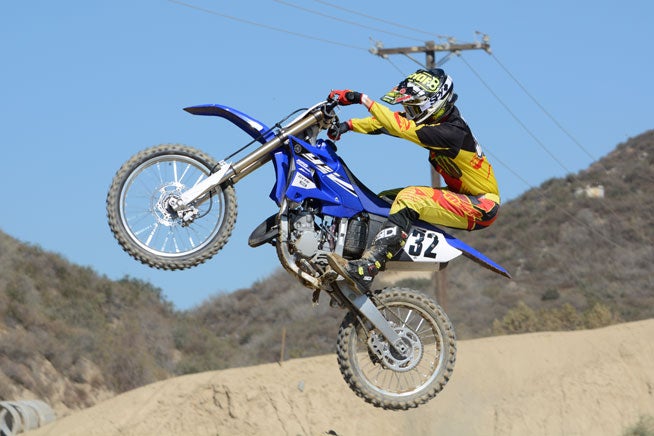
While the YZ125 is primarily intended to smooth the transition of young motocross riders coming off of an 85cc two-stroke, full-sized adults might be surprised at just how much zip the YZ125 has on the track.
“The fun factor of this bike? It’s so high there’s no comparison to anything else out there,” Bell said. “Sure, it’s more work if you really want to go fast because you have to really push hard everywhere, but it is a lot of fun to try.”
It’s also an excellent way to improve your speed on a bigger bike. That may sound a little backward, but if you want to go faster on a machine with more power, you should practice on a 125. Philosophically speaking, a 125 can still play an important and all-too-often forgotten role as the perfect machine to help aspiring young racers transition from 85cc two-strokes to four-strokes. That additional “work” of which Bell speaks is really not work in the strictest sense but rather a strengthening of such moto fundamentals as carrying optimum corner speed and conserving momentum. Smoothness is the key to speed on a 125, and that translates to even more speed when a rider graduates to larger displacement machinery. The YZ125 is the perfect tool for learning how to be smooth.
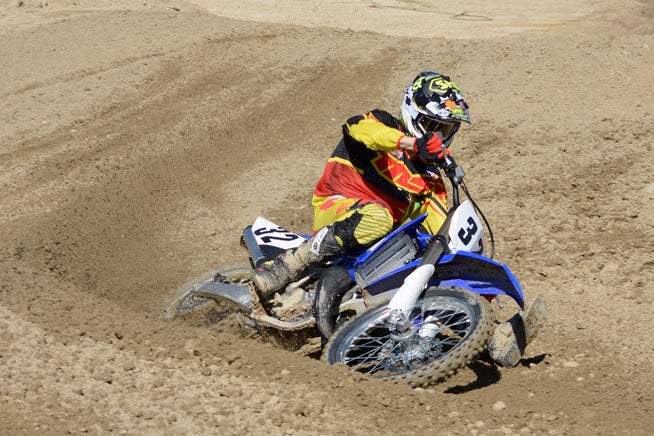
“It definitely makes a difference, and for me [as a racer] it is making a huge difference in the way that [four-stroke-reared] kids are riding the tracks these days,” Bell said. “On a four-stroke, you can just straight-line it into a corner, make a 90-degree turn, just smash the rut and then drop the hammer and go.”
That may be the easiest way to get the job done, but the four-stroke’s abundant low-end torque fosters a point-and-shoot style that won’t necessarily net a rider the fastest lap times.
“On a two-stroke, even on a 250, you set up a little wider, flow and carry more corner speed,” Bell said. “I think there is a lot of benefit to riding a two-stroke, especially a 125, as far as teaching corner speed and momentum. If you transitioned the lines that you learned in order to go fast on a 125 over to a four-stroke, I think you would be unbeatable.”
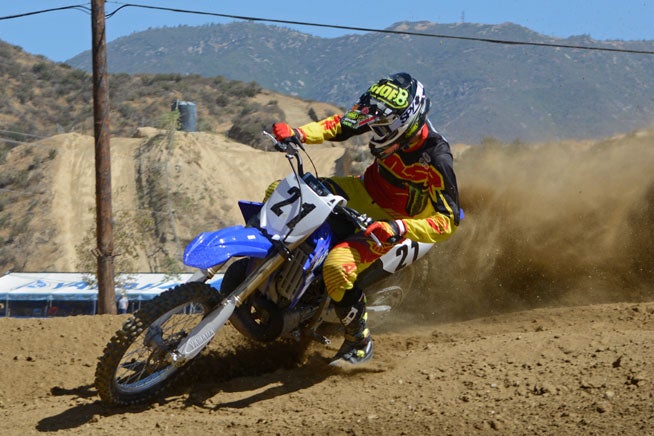
Naturally, the YZ250 allows the rider to be a tad lazier since it makes so much more torque and has a wider powerband than a 125. For a two-stroke, it is surprisingly friendly in its ferocity.
“The 250 is more of a mid-range motor for sure,” Bell said. “The meat of the power is in the mid-range. It will rev out if you need it to, but you can start to feel it fall on its face a little on the top-end. Off the very bottom it doesn’t quite have the pop to get you out of a loamy corner without clutching it, but if you keep your momentum up and keep it in the mid-range, it pulls really well.”
Both machines feature fairly slick-shifting transmissions and smooth, linear clutches. The 250’s transmission is a five-speed, while the 125 gets one extra gear and closer ratios to help keep it singing within its narrower powerband. Bell said that both machines were smooth and positive during upshifts, but he did notice one slight annoyance with the YZ125 when downshifting.
“Shifting down from third to second under braking on the 125 demands extra concentration to guarantee that the shift is made,” Bell said.
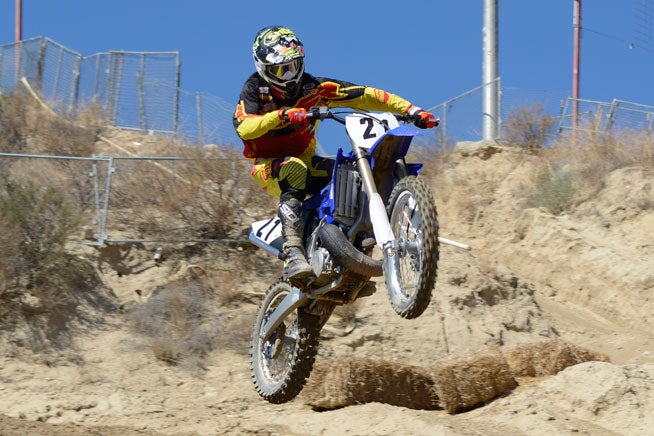
Neither machine possesses Yamaha’s excellent bi-lateral beam aluminum chassis, but their traditional backbone-style aluminum chassis are far from over the hill. Bell was clearly pleased at how well both bikes steered, flew through the air and tracked through Glen Helen’s notorious ruts.
“You have to commit when you’re diving into a corner, but they both go wherever you put them,” Bell said. “They follow ruts exactly like you want them to. They’re both light and flickable, they both turn really well and they’re both super-stable.”
Partial credit for the excellent handling is due the KYB suspension found on both YZs. It’s the same basic hardware as the units found on the YZF models, which arguably puts it on the cutting edge among conventional spring forks. Yamaha has done a good job sorting out the SSS fork for the two-stroke models. The KYB shock also holds up its end of the deal very well on the 125, but not quite as well on the 250, according to Bell.
“Suspension has never been that critical on a 125 to me because the bikes are so light to begin with, but the YZ125’s is really, really good,” Bell said. “I would maybe rework the valving just a little bit to make it a little stiffer for my weight, but overall it was excellent for the conditions we had at Glen Helen.
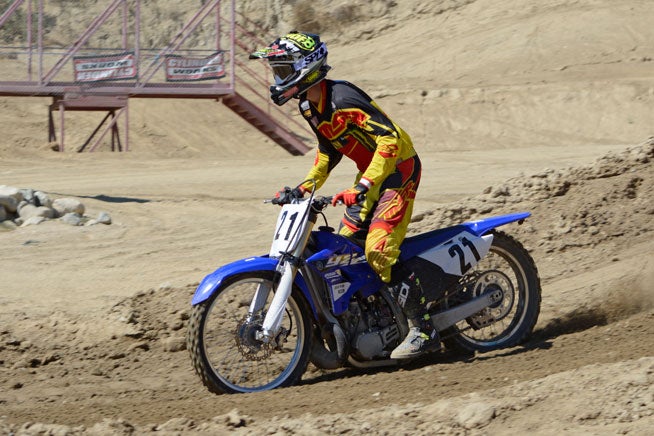
“When I first jumped on the YZ250, I felt that the shock could maybe absorb some of the chop a little better under braking, so we backed out a little bit on the high-speed compression, but then it got a little wallowy,” Bell added. “I would still take it the way it is without going back in on the high-speed, but if it were my bike I would definitely change the valving in the shock. The fork is really good [on the 250]. It tracks really well. I noticed just a little harshness low in the stroke under heavy, heavy braking, but we were able to adjust the compression and dial that out.”
Both machines also boast strong brakes, with wave rotors at both ends. Up front is a 250mm rotor with a twin-piston caliper. Out back, a 245mm wave rotor with a single-piston caliper gets the job done.
“You don’t really need awesome brakes on a 125, but the Yamaha’s are really good anyway,” Bell said. “They are strong, but they aren’t too touchy, so I didn’t find myself accidentally locking them up anywhere, and that’s a good thing. I did notice that on the 250, however, the rear brake was a little easier to lock up, and it also started squealing. That could be dirt, or it could be the pad compound. KTMs tend to do that a lot. It doesn’t affect the performance of the brake, but you just notice it.”
Of course, you can’t have fun if you’re not going comfortable, but YZs were comfortable enough for Bell’s 6-foot frame. Their layouts are similarly flat and narrow, their seats are slim with “gripper-style” covers that deliver plenty of traction, and both bikes offer come with adjustable top clamps that allow the rider to move the aluminum handlebar on both bikes to tailor the riding position. Bell required no adjustment to be happy, but the adjustable top clamp is still a nice feature.
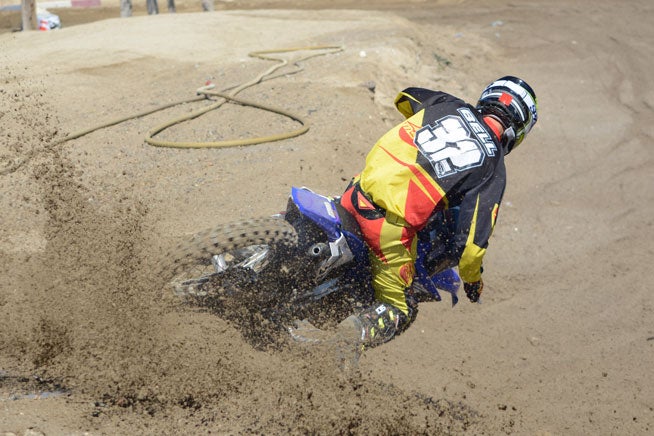
“I dropped right on the 250 and immediately felt comfortable,” Bell said. “I have long legs, so I can get cramped really easily. Other two-strokes I’ve ridden make me feel like my knees are up in my face, but the YZ250 was really comfortable for me. I was really happy with the bar bend, and the levers felt really good. I felt a little more cramped on the YZ125 than I did on the 250. The bars felt good, but the seat-to-pegs relationship is a little tight for my legs.”
We could go on about how the 2015 Yamaha YZ125 and YZ250 are as raceworthy as ever, and how they offer excellent bang for the buck with the added bonus of lower maintenance costs thanks to fewer moving parts in their two-stroke engines. That’s all true, but at the end of the day, their strongest selling point was evidenced by the big smile on Bell’s face.
“I’m glad Yamaha still makes these bikes,” he said.
Fun indeed.
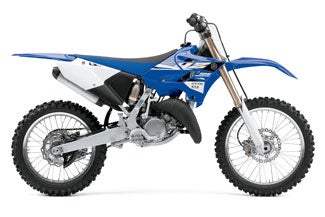 2015 Yamaha YZ125 Specifications
2015 Yamaha YZ125 Specifications
MSRP: $6390
Engine Type: 124cc liquid-cooled 2-stroke; reed-valve inducted
Bore x Stroke: 54.0 x 54.5mm
Compression Ratio: 8.6~10.7:1
Fuel Delivery: Mikuni TMX 38 carburetor
Ignition: CDI
Transmission: Constant mesh, 6-speed multiplate wet clutch
Final Drive: Chain
Suspension
Front: Speed-Sensitive System inverted fork; fully adjustable, 11.8-in. travel
Rear: Fully adjustable single shock; 12.4-in. travel
Brakes
Front: Hydraulic single-disc brake, 250mm
Rear: Hydraulic single-disc brake, 245mm
Tires
Front: 80/100-21 MX52 Dunlop
Rear: 100/90-19 MX52 Dunlop
Seat Height: 38.4 in.
Wheelbase: 56.8 in.
Ground Clearance: 14.4 in.
Fuel Capacity: 2.1 gal.
Claimed Wet Weight: 209 lbs.*
Color: Team Yamaha Blue/White
*Wet weight includes the vehicle with all standard equipment and all fluids, including oil,
coolant (as applicable) and a full tank of fuel.
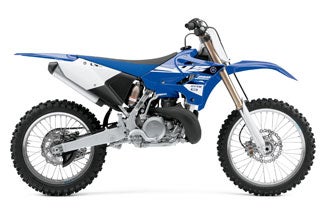 2015 Yamaha YZ250 Specifications
2015 Yamaha YZ250 Specifications
MSRP: $7290
Engine Type: 249cc liquid-cooled 2-stroke; reed-valve inducted
Bore x Stroke: 66.4 x 72.0mm
Compression Ratio: 8.9~10.6:1
Fuel Delivery: Keihin PWK38S carburetor
Ignition: CDI
Transmission: Constant-mesh 5-speed; multiplate wet clutch
Final Drive: Chain
Suspension
Front: KYB 48mm Speed-Sensitive System inverted fork; fully adjustable, 11.8-in. travel
Rear: KYB fully adjustable single shock, 12.4-in. travel
Front: Hydraulic single-disc brake, 250mm
Rear: Hydraulic single-disc brake, 245mm
Tires
Front: 80/100-21 MX52 Dunlop
Rear: 110/90-19 MX52 Dunlop
Seat Height: 39.1 in.
Wheelbase: 58.3 in.
Ground Clearance: 15.0 in.
Fuel Capacity: 2.1 gal.
Claimed Wet Weight: 227 lbs.*
Color: Team Yamaha Blue/White
*Wet weight includes the vehicle with all standard equipment and all fluids, including oil,
coolant (as applicable) and a full tank of fuel.
 Your Privacy Choices
Your Privacy Choices